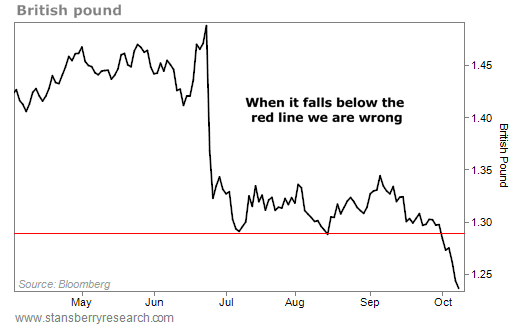| Home | About Us | Resources | Archive | Free Reports | Market Window |
How I Know When I'm Wrong – And How I Get OutBy
Tuesday, October 11, 2016
I told you what I look for to "get in" an investment here and here. But what happens if things go wrong? When do I "get out"?
Let me turn the question back on you... When do YOU get out? At what point do you KNOW you're wrong?
What? You don't know?
This is YOUR MONEY. You worked hard for it. And you're just "winging it"? You're just "shooting from the hip"? Really?
We've got to change that, RIGHT NOW...
I have a perfect example of how I know I'm wrong in a trade... and when it's time to get out.
The example is real. My paid subscribers just went through it last week. I will tell you what the investment is – but frankly, that doesn't matter. What matters is the lesson.
Less than a month ago, I recommended that my subscribers buy the British pound...
The British pound had fallen to its lowest level in 30 years. And it was extremely hated – speculators had placed large bets against it. But we saw the start of an uptrend in place. It was worth a speculation. So here's what I told my subscribers...
This is how I trade. It's all about the odds... When you have the setup you want to see... and your upside potential is four times your downside risk, you enter the trade.
So we entered the trade. But we got stopped out at the recent lows (a 4% loss). No big deal. Then, the big deal arrived... The bottom fell out of the British pound. Take a look...
 You can see the British pound had hit new lows in July and August. When we entered the trade in September, I said to GET OUT if the British pound closed below those lows because that would mean I was wrong. The British pound closed below those lows. It was time to get out. People who followed my advice lost no more than 4%.
After that, the bottom fell out... And the British pound kept falling, and falling, and falling.
So let me ask you again... If you are "just winging it" or "shooting from the hip," when will you get out of a trend like this one? Now? Or will you buy more and double down?
What's your plan? Do you know your upside potential and your downside risk? You don't know if you don't have a plan.
I know when the market is telling me I am wrong about an investment idea (when it hits a new low).
Remember, I wait to buy until there's an uptrend in place. So a new closing low means that I am totally wrong about that uptrend. I get out the next day.
When are you wrong? When do you sell?
It's fine if your exit plan is different... But my goodness, have a plan – and follow it!
Good investing,
Steve
Further Reading:
Last week, Steve gave a step-by-step breakdown of when to enter a trade... and when to stay on the sidelines. To learn Steve's strategy and master the art of waiting for the uptrend, read here and here.
Most people will never have a "sixth sense" for trading... and just "trusting your gut" can lead to major losses. Recently, Doc Eifrig shared three simple steps to help you invest intelligently – and avoid gambling with your portfolio. Get the full story here.
Market NotesA GOOD SIGN FOR THE BULL MARKET Transportation stocks hit a new 10-month high last week... And that's good for the bull market in stocks.
The "transports" are a widely followed sector, thanks to Charles Dow, the legendary founder of the Dow Jones Industrial Average. He also developed a famous method of stock-market analysis called "Dow Theory."
One of Dow Theory's main ideas is to monitor both industrial shares (the manufacturers of goods) and transportation shares (the transporters of goods). This gives us a "big picture" view of the economy and the overall stock market. Dow reckoned that if both manufacturers and transporters were enjoying higher stock prices, they were confirming a bullish trend.
As you can see in the following chart of the Dow Jones Transportation Average – which tracks America's largest railroad, trucking, and freight companies – the index is in an uptrend and just broke out to a new 10-month high. It's still a "Dow Theory confirmed" bull market.
 |
Recent Articles
|



